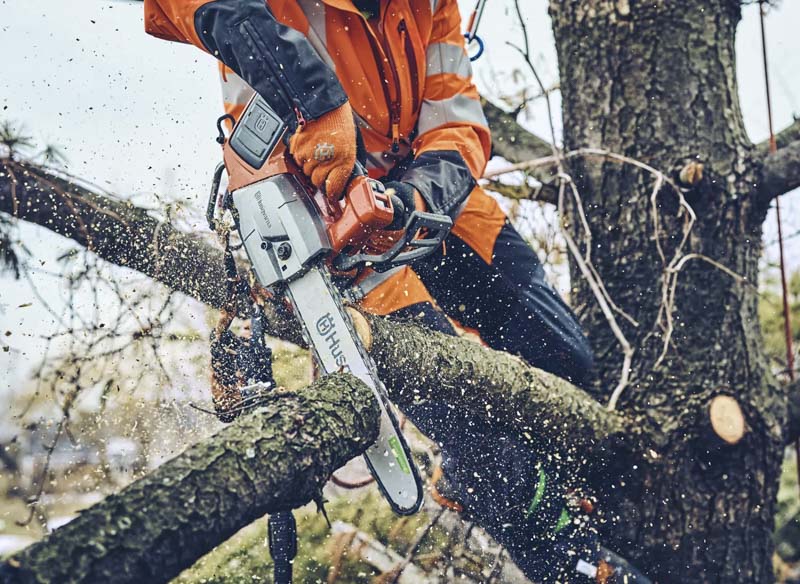In Arikok National Park on Aruba, a locally extinct parrot known as the Lora (a Yellow-shouldered amazon) has just been reintroduced to the wild/Jennifer Bain
When the park truck pulls up to Plantage Prins at sunrise, a dozen young parrots start swooping about, a couple even landing on the hood with expectant looks. We’ve brought a breakfast feast of fruit, vegetables and legumes to get these pampered birds ready for another day in Aruba’s Arikok National Park foraging for wild food and learning to dodge Peregrine falcons.
“Hello. Hello. Hi,” chief conservation officer Natasha Silva says softly to her feathered friends. “That means they’re hungry when they fly down.”
It’s tough to say what’s more unusual, seeing park staff feed wildlife or hearing how these Yellow-shouldered amazons returned to this island after last being seen in the wild nearly 77 years ago.
Silva was having lunch on a Saturday in the summer of 2022 when she got an urgent call from Ursell Arends, Aruba’s minister of nature. The coast guard had intercepted a smuggling boat full of people fleeing nearby Venezuela’s economic and political turmoil. They were carrying 33 Loras, monkeys and other poached wildlife.
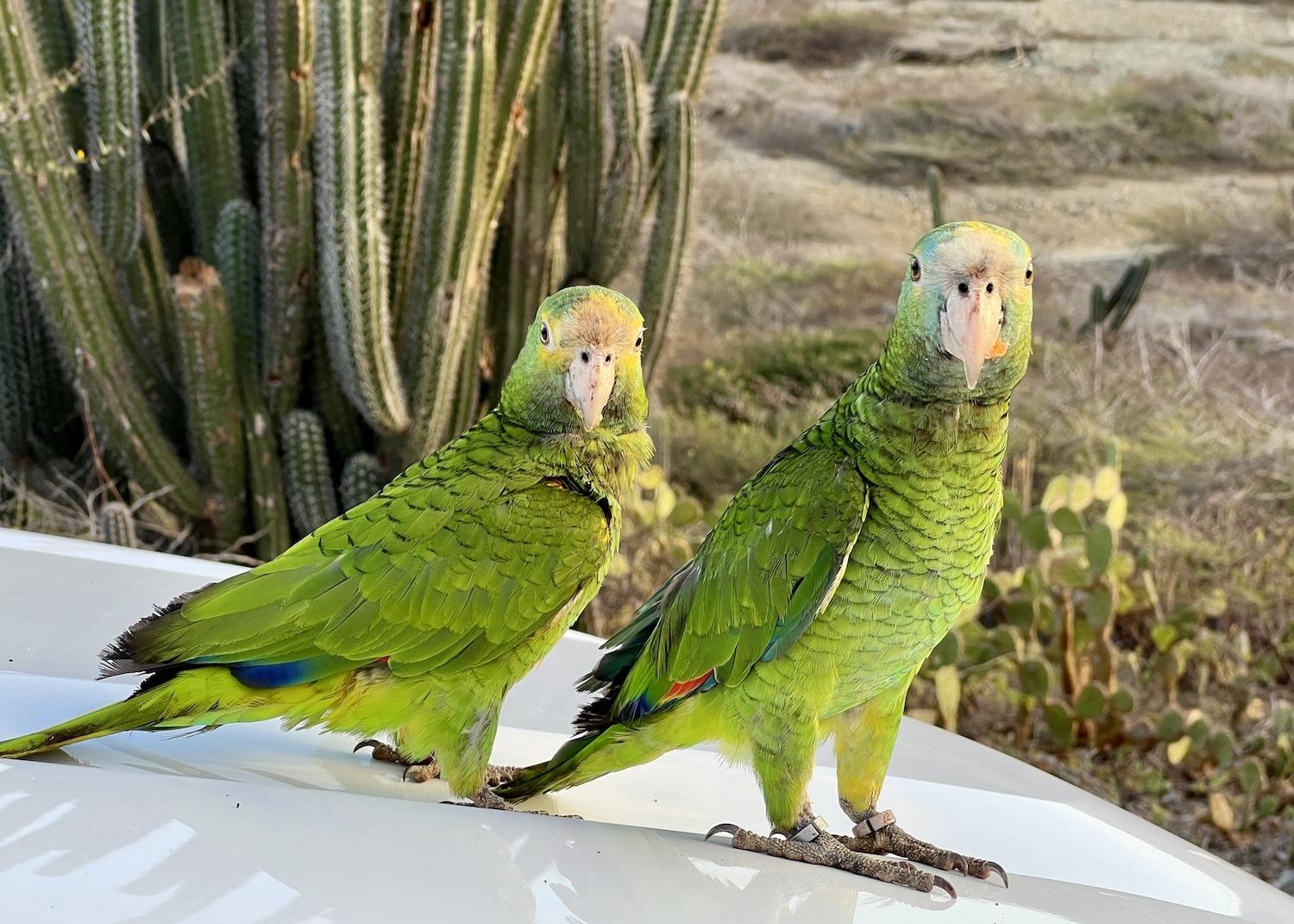
Two Yellow-shouldered amazons (Loras) land on a Arikok National Park truck in Aruba in April/Jennifer Bain
Normally, all these creatures would be euthanized to deter the illegal pet trade. But the minister knew that the Fundacion Parke Nacional Aruba (the Aruba National Park Foundation) hoped to reintroduce Loras.
“Natasha, come pick them up now,” the minister said. It was two years ahead of schedule but Silva of course said yes. Through a ministerial decree, the foundation was appointed to conserve the Loras. The species also became protected by law.
The stressed babies were in rough shape. Several died during a quarantine while the rest battled malnutrition and dehydration. Everyone pitched in to nurse them back to health.
Aruba is one of the Lesser Antilles islands in the Southern Caribbean Sea and it’s just 15 miles north of Venezuela. A constituent country of the Kingdom of the Netherlands, the tiny island of 110,000 has picture-perfect beaches but a rugged terrain and desert-like hills studded with cacti. Licence plates say “One Happy Island.” A popular tourism slogan is “70 square miles of happiness.”
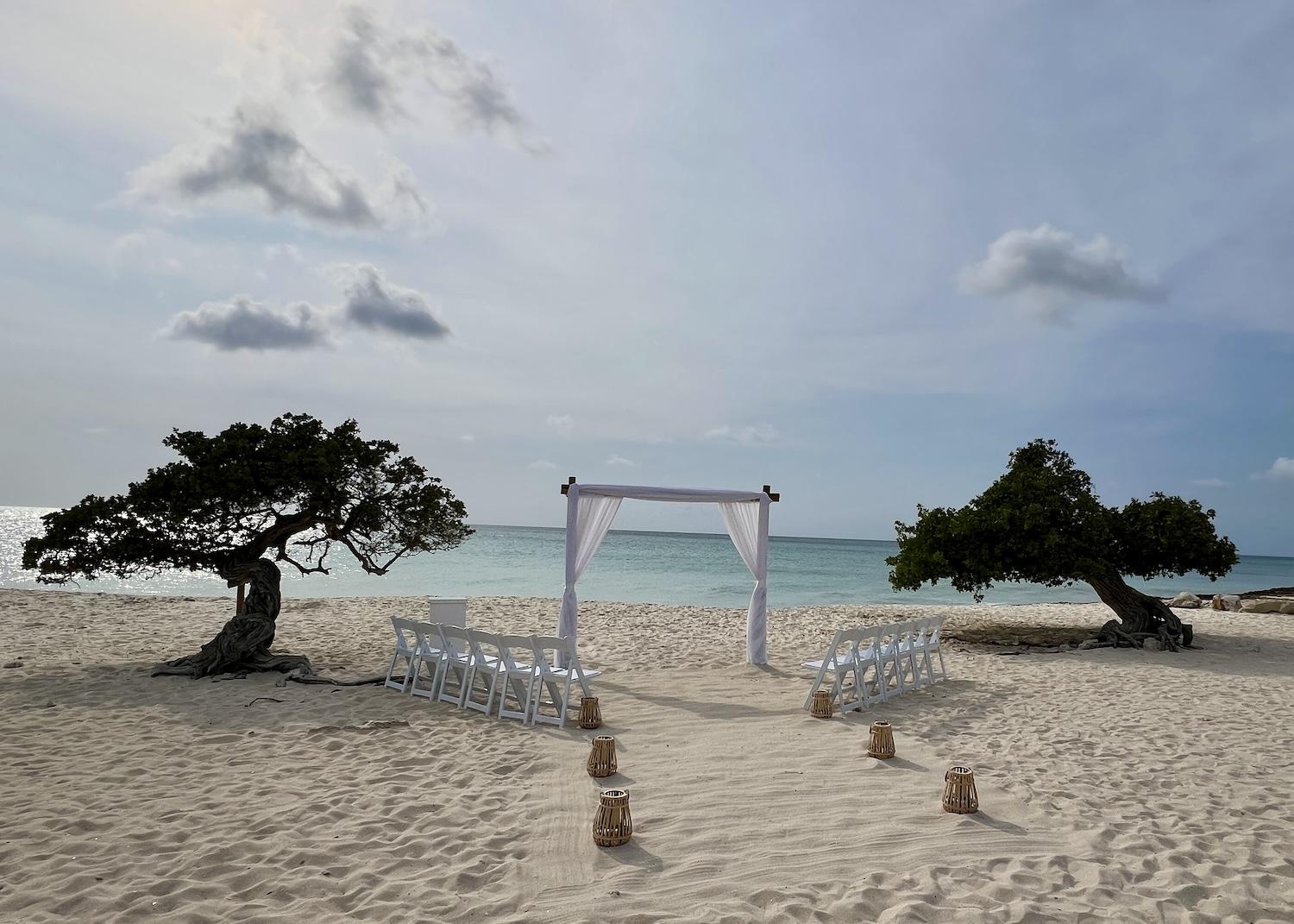
Aruba is known for its white sand beaches (and the Fofoti tree of Eagle Beach, right), but the small, desert-like Caribbean island is also studded with cacti/Jennifer Bain
It’s fair to say the Lora (Amazona barbadensis) was loved to death here.
The clever, friendly bird has long been a treasured pet. The large, green parrot with the yellow face, yellow shoulder patch and orange wing patch loves desert scrub areas. Poached for the pet trade, killed for being considered an agricultural pest and pushed out of its habitat by deforestation and development, it was last seen in 1947.
The Lora was declared extirpated (locally extinct), meaning it could no longer be found in the wild in Aruba but continued to exist in isolated places on Bonaire and Curaçao, and in northern parts of Venezuela and the Venezuelan islands of Margarita and La Blanquilla. With wild populations estimated to be less than 10,000, the Lora was declared “near threatened” on the IUCN Red List of Threatened Species in 2021.
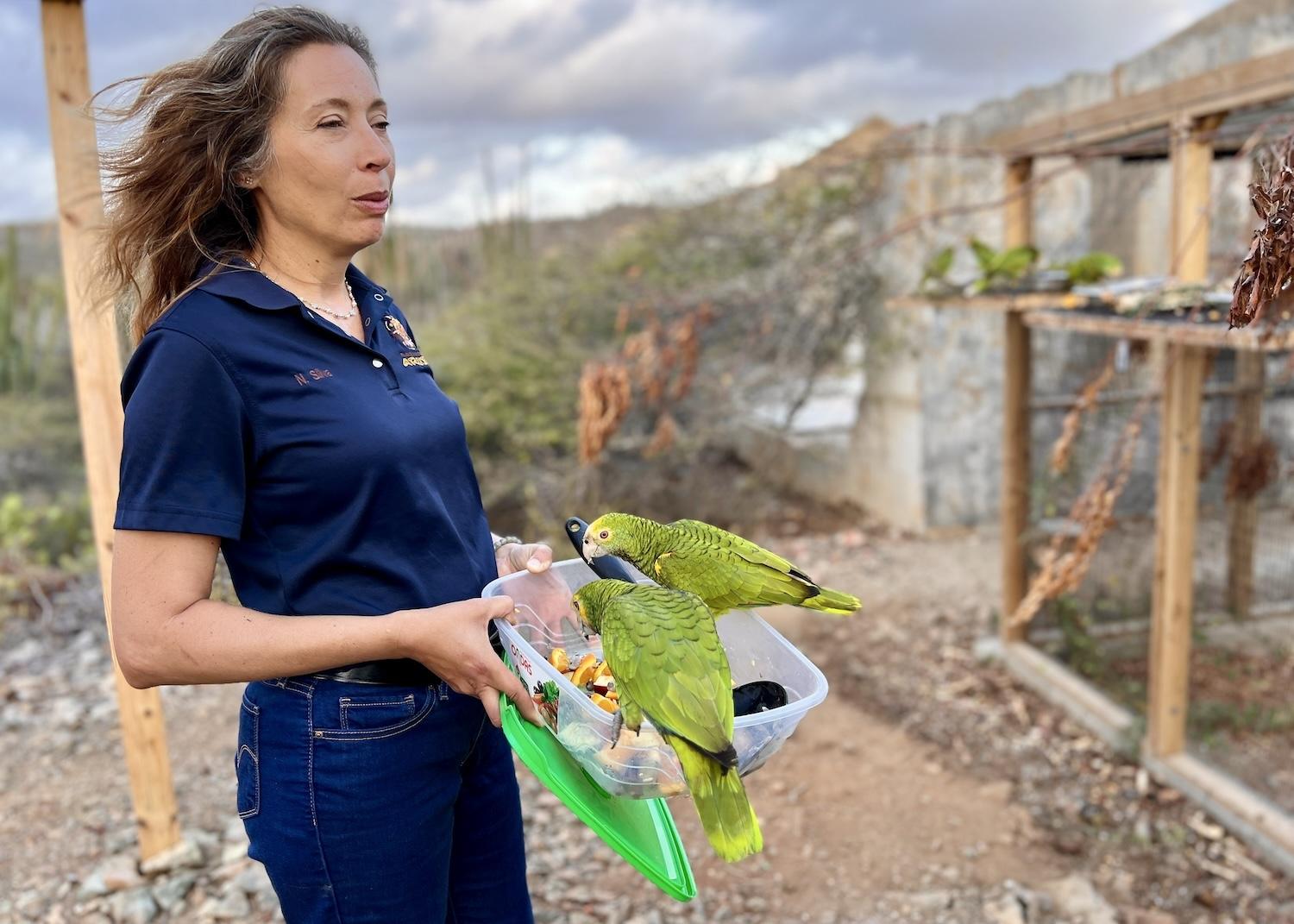
Natasha Silva, the chief conservation officer for the Aruba National Park Foundation, delights in caring for the Loras they rescued from smugglers in 2022 and reintroduced to the wild in January/Jennifer Bain
“We do this just to keep them fit until they’ve spent a year in the wild and learned where all the food sources are,” says Silva as she gives the Loras chopped oranges, apples, bananas and green bell peppers along with cooked chickpeas and other legumes.
Back in 2022, rangers quickly built a huge flight aviary for 25 surviving Loras in a secret location outside the park. They enlisted the World Parrot Trust, Vogelpark Avifauna in the Netherlands and other experts for guidance, even sending bird poop to the U.S. and Europe for regular analysis. They followed in the footsteps of a similar program in Bonaire.
As the birds gained strength and learned to fly, rangers built a “release aviary” at the site of a former coconut plantation in the park, near the main paved road but just out of sight of most visitors. Then, over three days in January, they released 25 Loras.
“After a year and a half of thorough care, monitoring, and learning, we are overjoyed to witness the return of the Lora to Aruba’s nature after a long 76 years,” the foundation announced on Facebook.
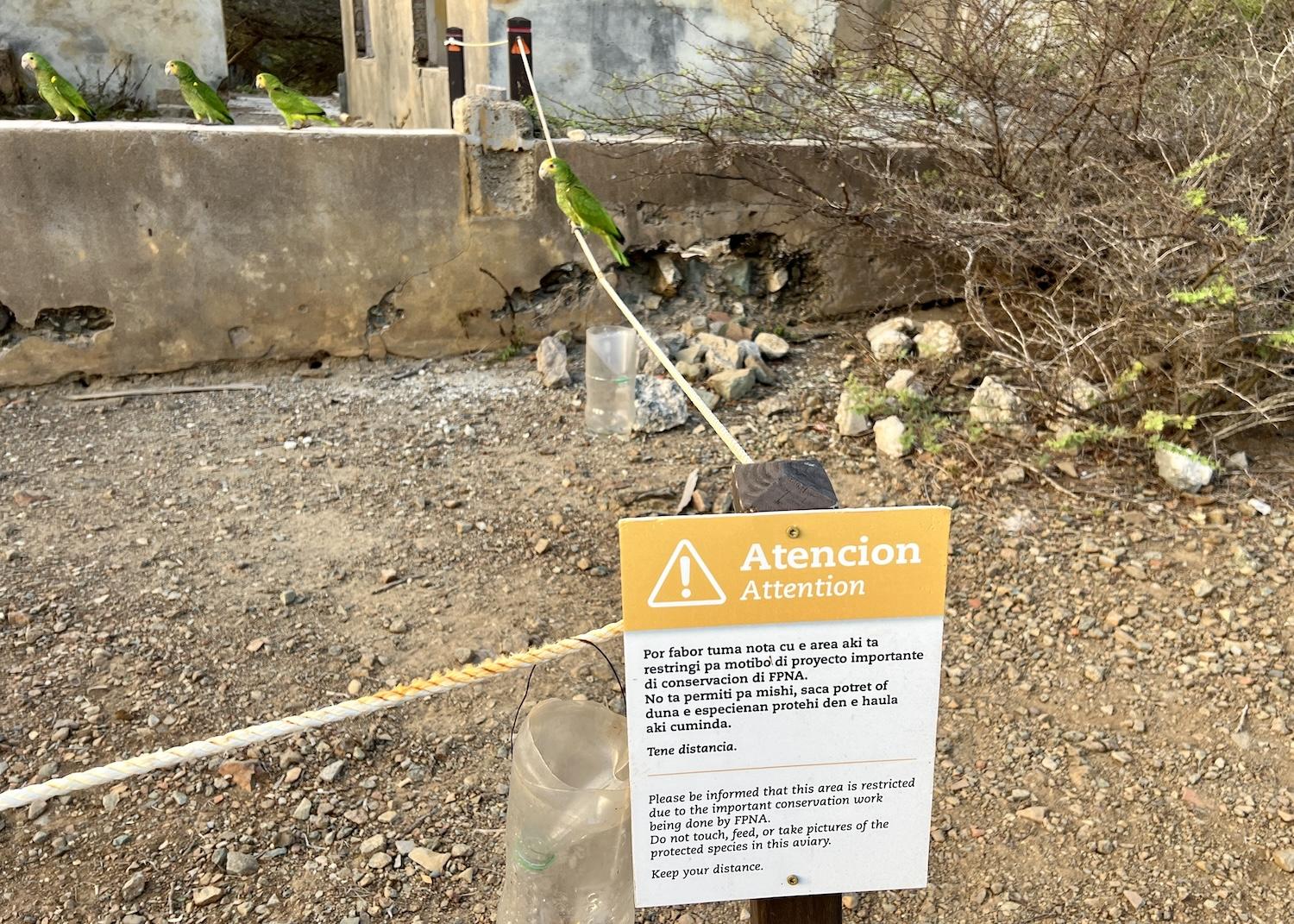
If Arikok National Park visitors stumble upon the flock of newly reintroduced Loras, they are asked to show respect and keep their distance from the parrots/Jennifer Bain
The flock is flourishing and has been spotted by hikers and rangers.
The Loras have abandoned chicken-like feeding habits — eating when on the ground — and now forage for cacti, yuwana and hubada beans. They’re exploring the park and beyond and becoming less dependent on humans and feedings. They’re more alert to danger, making soft prrrrrrrs that signify vigilance against potential predators, freezing and remaining motionless when needed.
Park staff still give the Loras supplementary food at breakfast and dinner — equal parts fruits, veggies and protein-rich legumes — and let them forage the rest of the day.
“They have a handicap because they were brought up in captivity and there are no adults around to teach them,” Silva points out. “Parrots are very intelligent animals. A lot is instinct, but a lot is taught.”
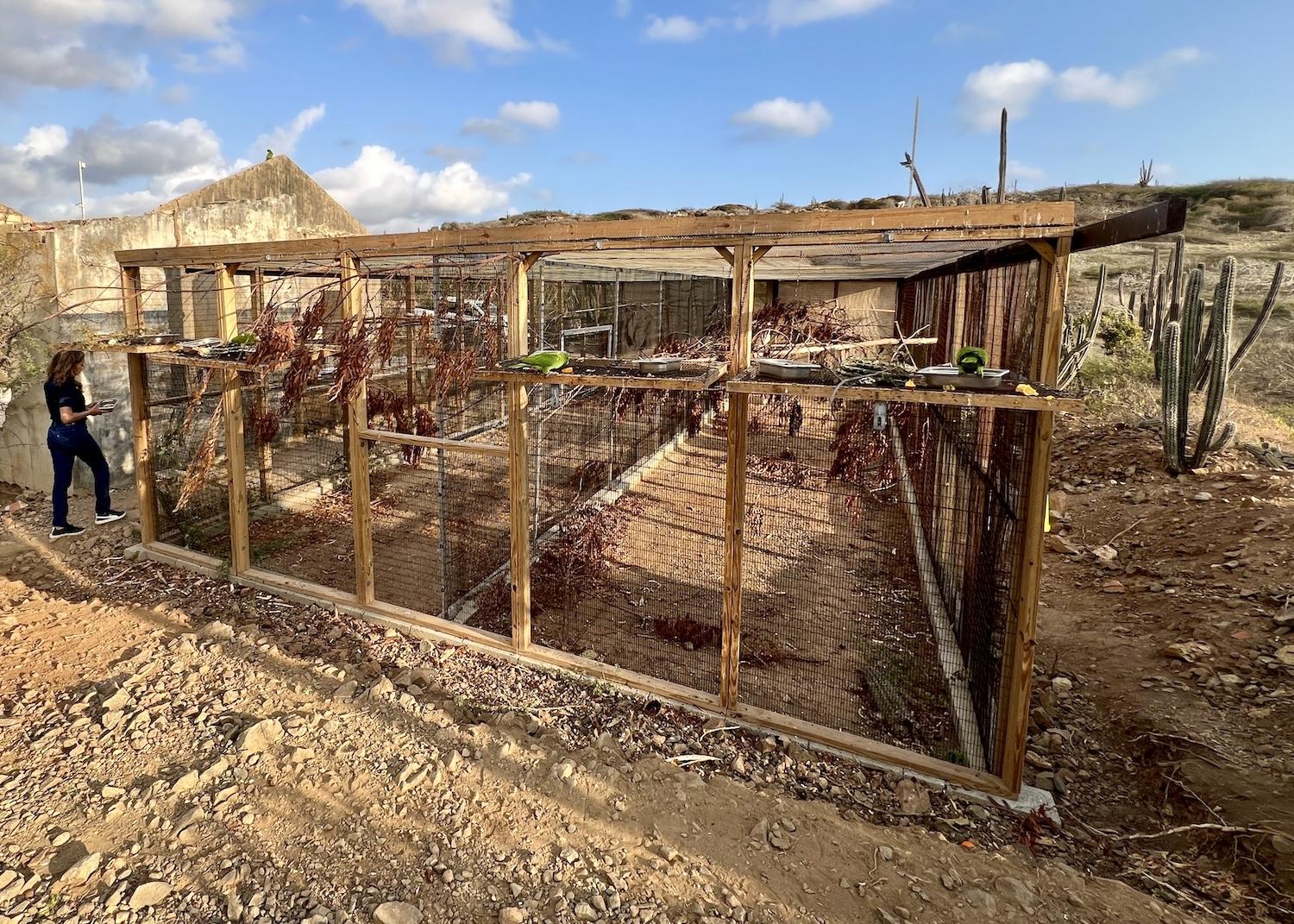
The Loras are now free to come and go from an aviary that was built for them in Arikok National Park on Aruba/Jennifer Bain
With the aviary as an optional home base, and a daily feeding and watering schedule, rangers keep watcheful eyes on the Loras. That’s how they saw them fend off six weeks of Peregrine falcon attacks.
“I was not sleeping and got so many gray hairs,” Silva remembers from that harrowing time. “Now I’ve had two weeks of no Peregrine, knock on wood.”
Roger Solagnier, a plant expert who also cares for the Loras, has even had Peregrine nightmares. In one, he saw Loras flying through the canyon but then heard the screech of a Peregrine and saw it grab one Lora with its right talon, one with its left and one with its hooked beak.
“Which is absurd,” the ranger acknowledges. In real life, the parrots are “out flying and looking for Peregrine all the time.”
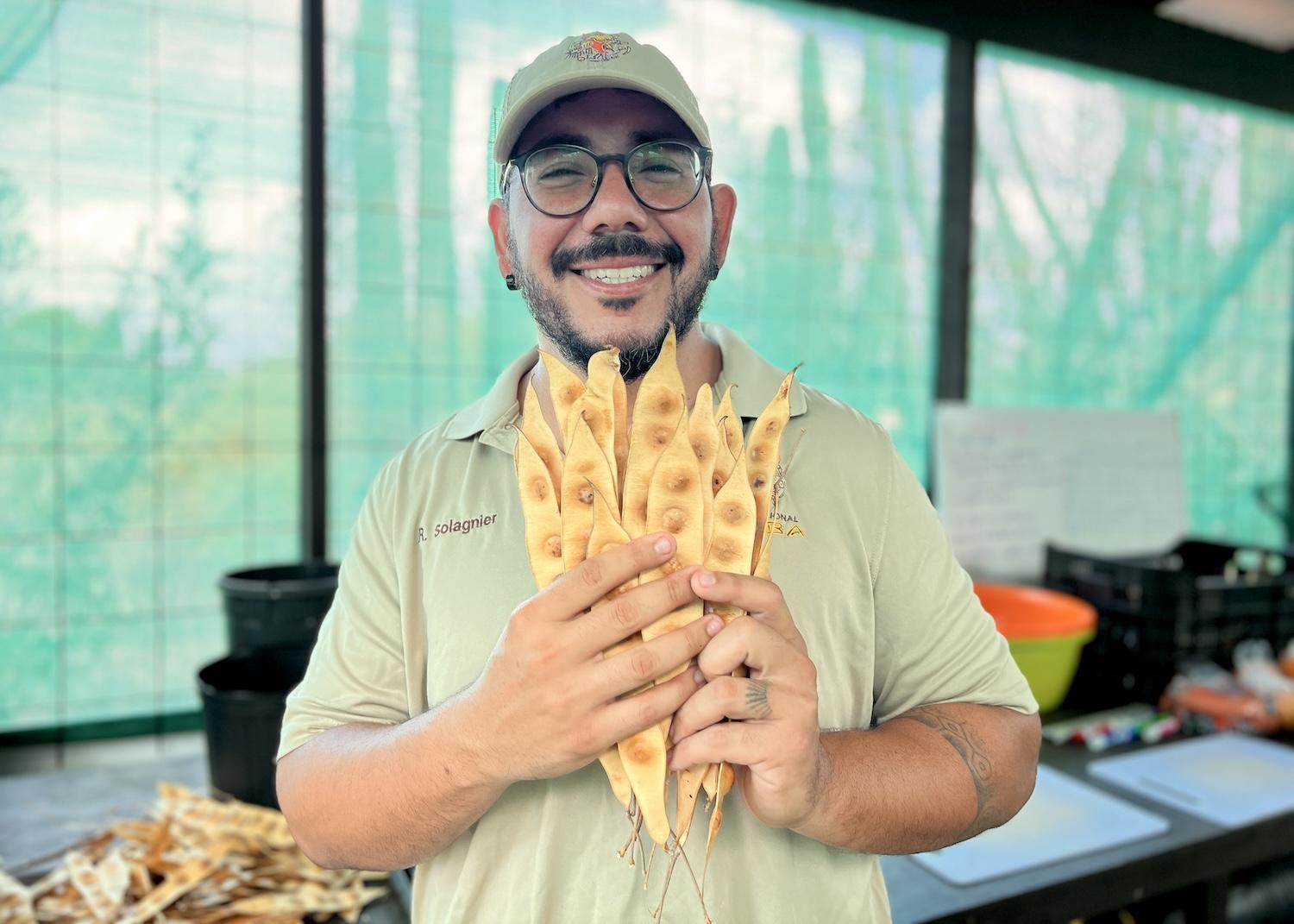
In a greenhouse in Arikok National Park, ranger Roger Solagnier grows shrubs and trees for habitat restoration and to feed the Loras. These are pods he collected/Jennifer Bain
The park will ultimately accept that Peregrines are a natural predator. “It’s just that this group of Loras is a baby group and they have no adults to teach them in the wild how to deal with these kinds of things,” says Silva. “So a year on, we will be like `Okay you are out here fending for yourself.’ But for now, we’re still trying to ward off the Peregrine as much as possible.”
Since the parrots are roughly 18 months old and don’t typically start reproducing until they’re about seven, the modest goal of the foundation’s Species Conservation and Reintroduction Program is to establish a self-sustaining wild Lora population by 2043.
The foundation, meanwhile, is evolving from a park management organization into a nature conservation organization and is poised to rebrand as the Aruba Conservation Foundation.
Established in 2000, the foundation manages 24.3 per cent of Aruba’s natural terrain and 0.2 per cent of its territorial waters. It cares for four Marine Protected Areas, the Spanish Lagoon (a RAMSAR site and wetland of international importance) and Arikok National Park, which accounts for 18 per cent of its land.
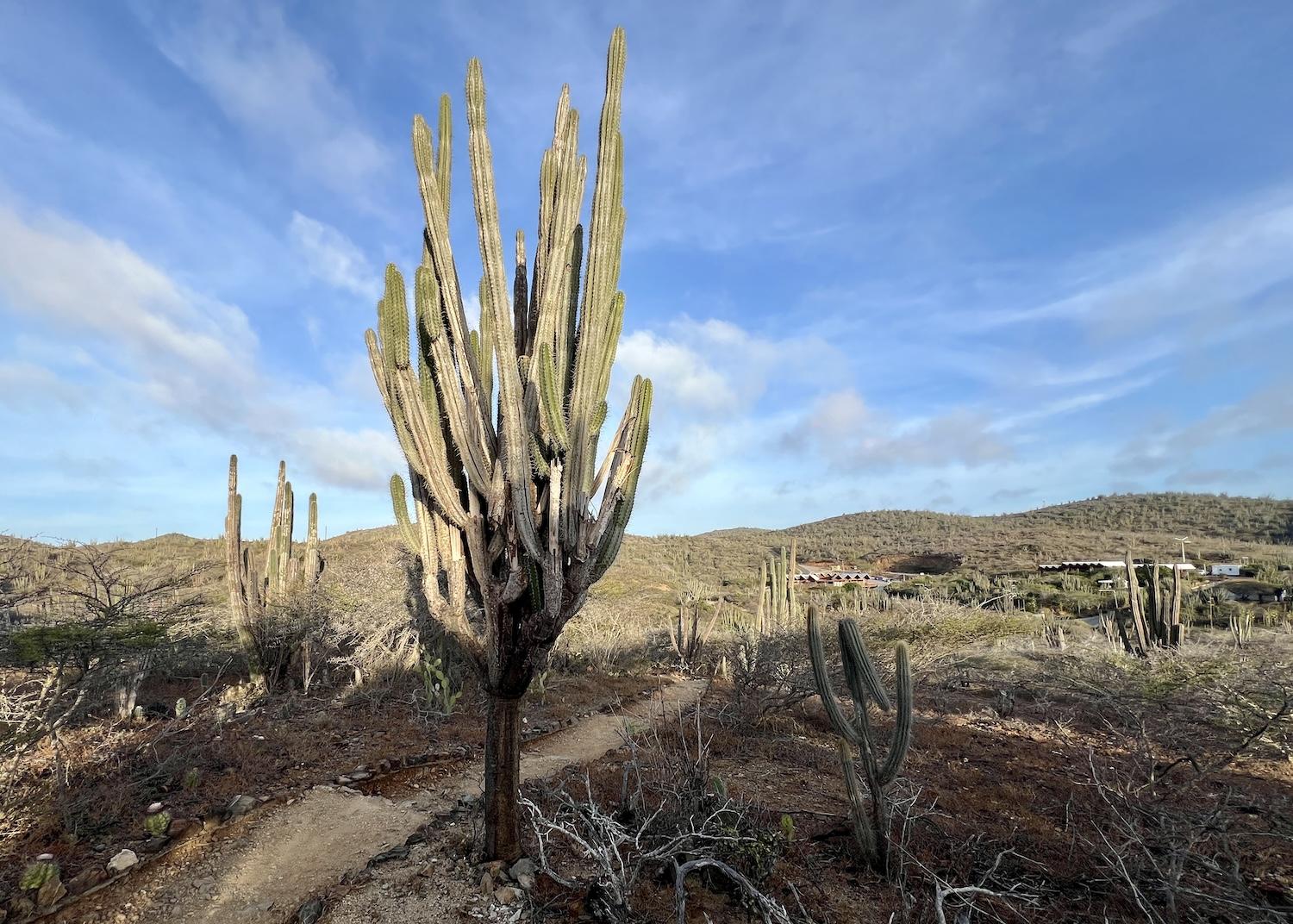
A view of the desert-like landscape near the Arikok National Park visitor center in Aruba/Jennifer Bain
“I must say Arikok is a precious piece of nature that hopefully will remain what it is for future generations,” says Ewald Biemans, who is on the park foundation board and is the owner/CEO of Bucuti & Tara Beach Resort.
The hotelier introduces me to Paco, a Yellow-headed amazon who was found on the side of the road by an employee in 1991 and has lived at the resort ever since. And while Paco favors the ladies, everyone loves him. Two of Aruba’s national birds — Brown-throated parakeets known locally as Prikichi — live beside Paco. Jessy was found on the grounds by a guest in 2012 and James landed on her cage, wouldn’t leave and flew inside when the door was opened.
“He’s actually not a rescue,” says Biemans, “but he’s rescuing Jessy.”
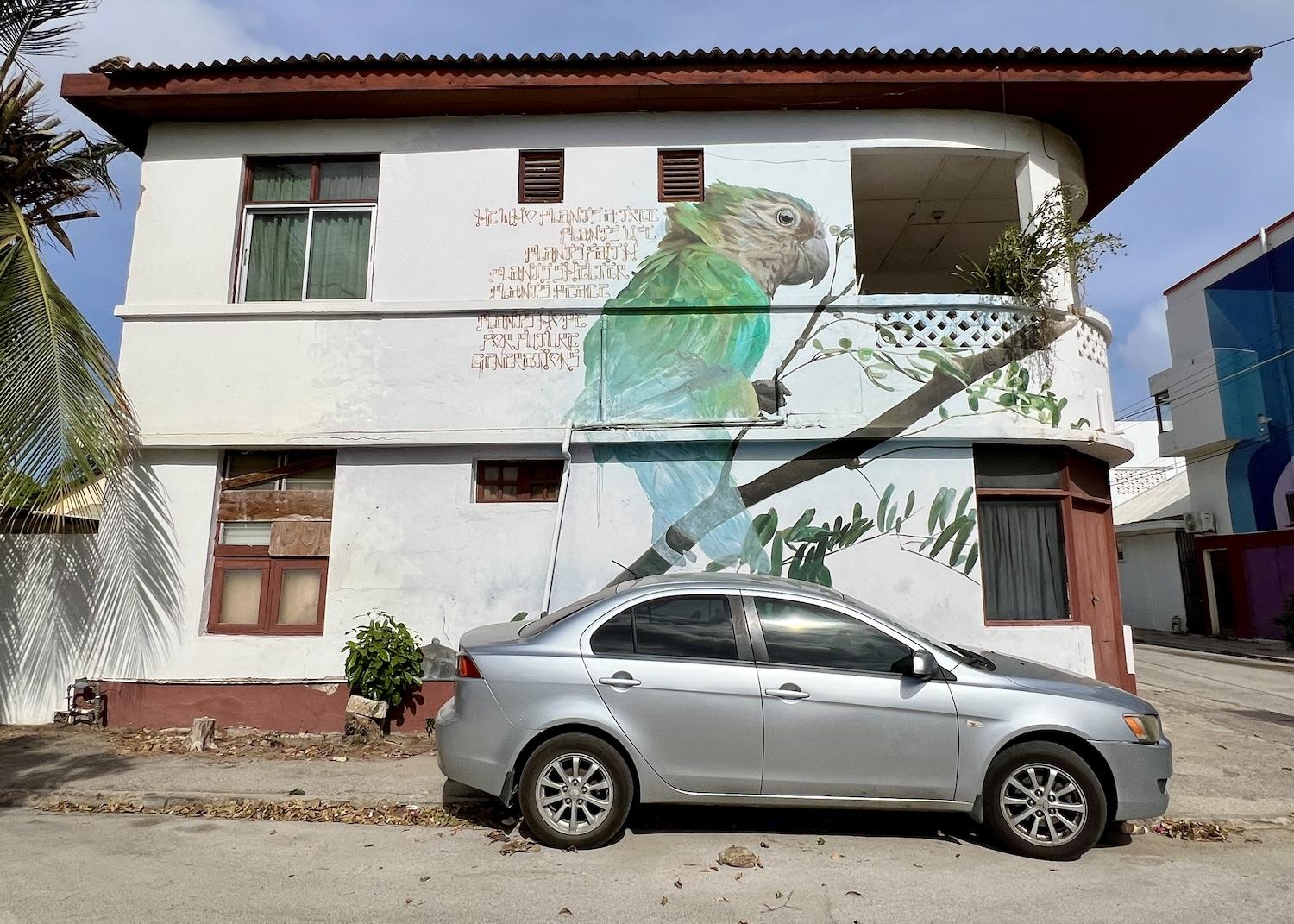
In San Nicolas, this 2017 mural by Garrick Marchena is called “Prikichi Please Don’t Go.” The artist says it shows Aruba’s national bird slowly fading away because it’s under threat from human development and invasive boa constrictors/Jennifer Bain
Nobody knows the size of Aruba’s captive bird population. But the foundation must now convince locals that parrots and parakeets should no longer be considered pets. It hopes to soon be able to take surrendered birds, but that doesn’t mean people should give up pets that have spent decades in captivity.
“Lora can become 40 years old,” Silva points out. “It would almost be cruel to release a Lora that is 30 years old into the wild. But some people do feel really guilty now that they know.” It will be a huge learning process “so we’re doing it in a soft way. It’s really difficult to do hard enforcement.”
The foundation will educate school children. It also just signed a strategic agreement with the Aruba Tourism Authority to continue collaborating to protect and preserve nature while educating locals and visitors on the importance of nature conservation.
For Loras, that means “raising pride that we have a wild population and having people be part of the conservation team,” says Silva.
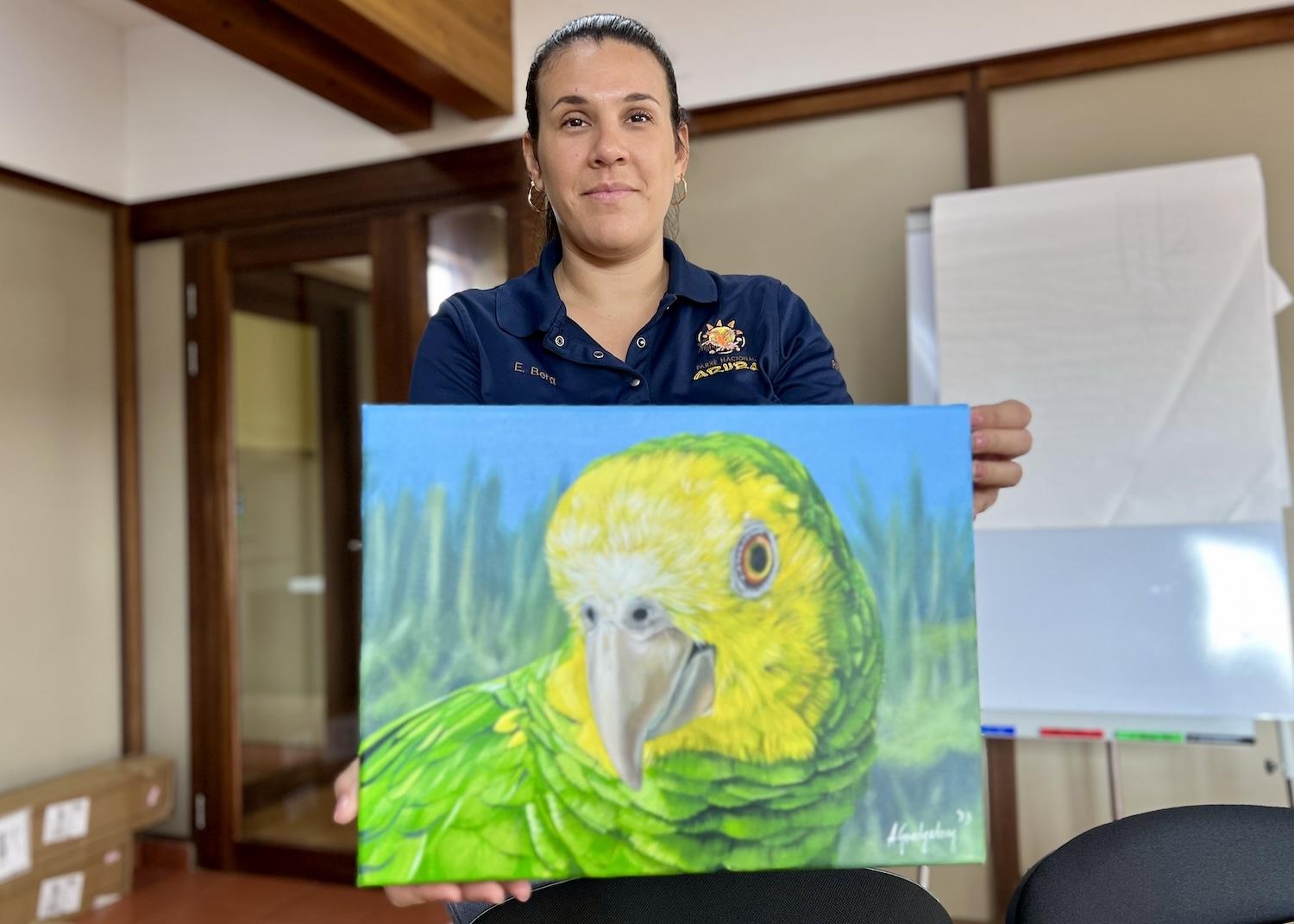
At the Aruba National Park Foundation office, communications and marketing manager Edeline Berg shows off a Lora painting by local artist Armando Goedgedrag/Jennifer Bain
We must show respect for Loras by keeping our distance and keeping cats and dogs away from them. We shouldn’t feed or capture the parrots, and should report any sightings of birds with one or two colored leg rings to a wildlife hotline.
Not only must the Loras face old enemies like pet trade poachers, they must now cope with invasive species and predators like rats, feral and domestic cats, and boa constrictors.
Contrary to popular belief, boas didn’t cause of the disappearance of the Lora since the non-native species was only introduced here in the 1990s. The good news is that the snakes gravitate to urban areas for food, but nobody knows yet how they will will coexist with Loras.
What is known is that Loras — once the predominant parrot species in Aruba — help disperse plant and tree seeds that then proliferate and support other wildlife. This important cultural species plays a key role in the island’s biodiversity.
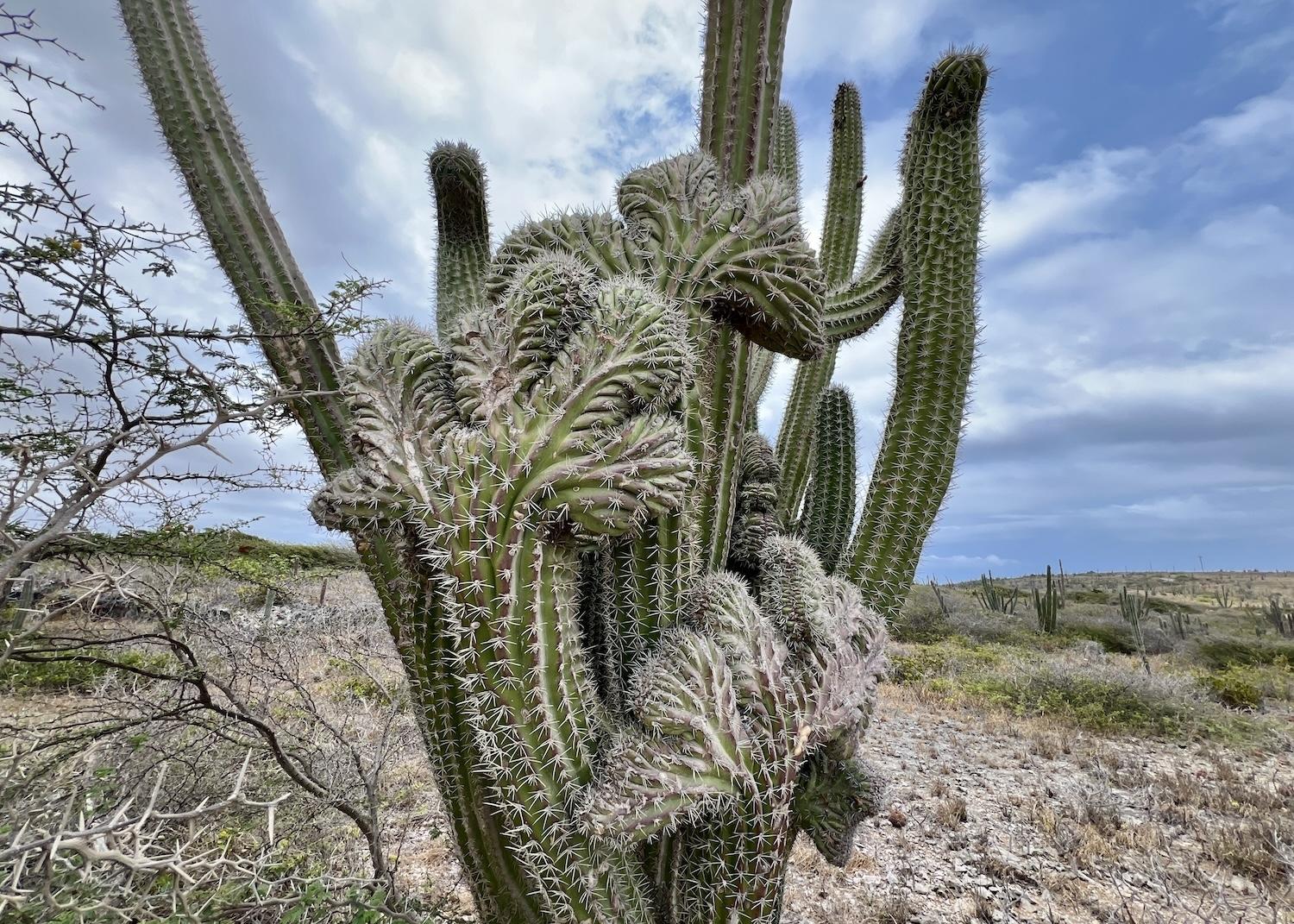
The kadushi (also spelled cadushi) cactus flourishes in Aruba, often with a mutation that causes cresting/Jennifer Bain
Spanish settlers dubbed Aruba, Bonaire and Curaçao as “Islas Inútiles” (Useless Islands) since they lacked precious metals. Because of its semi-arid climate, Aruba isn’t lush and didn’t have as many slave-based cotton and sugar cane plantations as other Caribbean islands.
It’s dry season when I visit in April, basing myself at the low-rise Amsterdam Manor Beach Resort that’s across from Eagle Beach’s iconic Boboti tree and is a 25-minute drive to the park. I get to tour the park’s greenhouse to learn about a Flora Biodiversity Enhancement Program that’s nurturing native and threatened shrubs and trees. Seedlings will be used for habitat restoration and food for the Lora.
“We give them browse (leaves, twigs and buds) with branches so they recognize the trees,” says Silva, as she doles out buttonwood, tree of life (moringa) and mangrove plants.
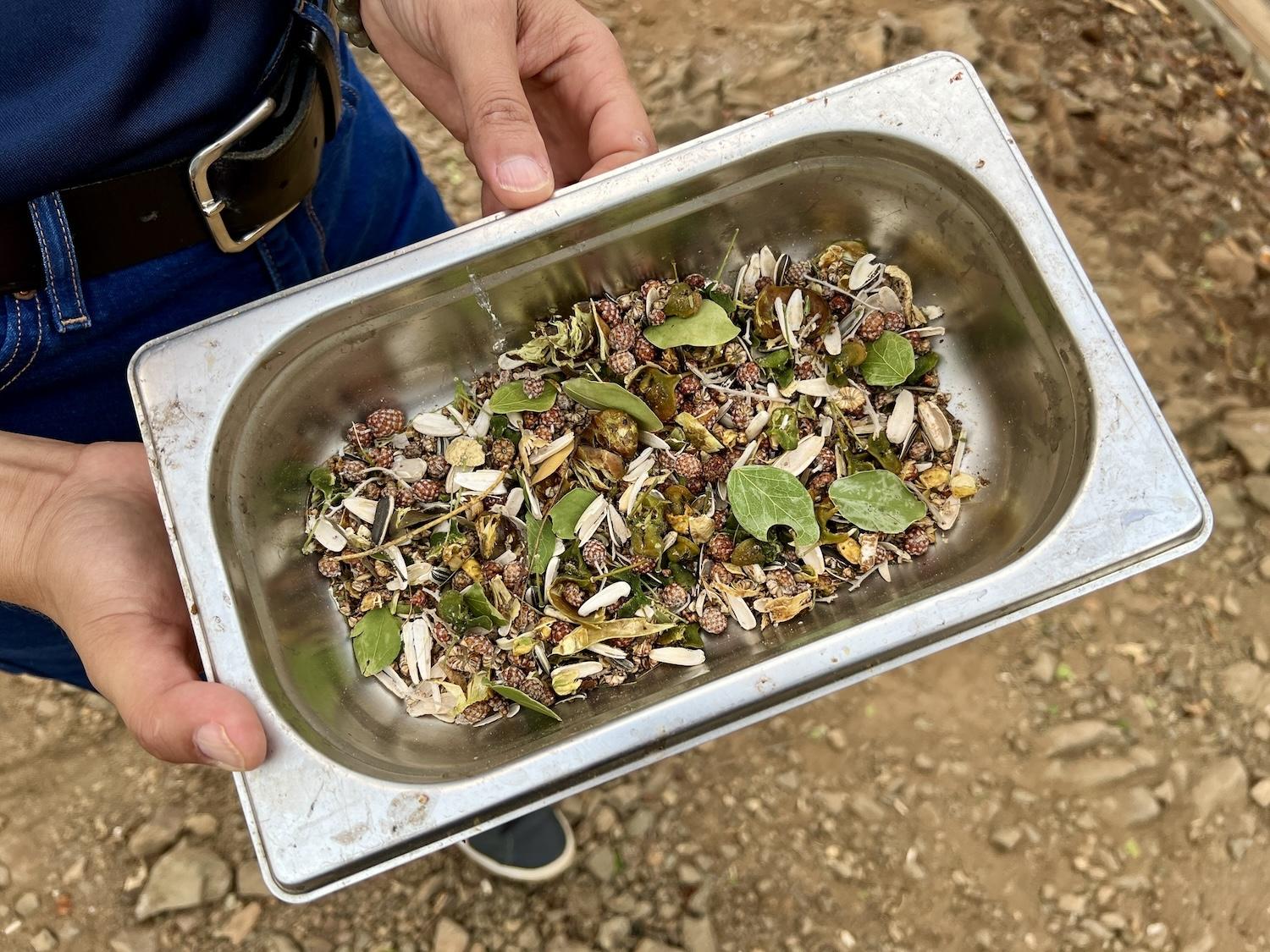
Park rangers collect “browse” for the Loras to help them get to know the look and taste of the wild food they should be foraging for themselves/Jennifer Bain
Suddenly most of the flock startles and takes off in a squawking flurry of green.
“They dispersed as a group which is very unusual,” frets Silva. “I don’t know what’s happening.” She soon spots a Crested caracara, a bird of prey.
Normally it takes rangers two hours to feed and water the Loras, weigh some of them, and replace their browse. Long branches of neem — an invasive species from Indian with medicinal properties — are strategically placed in the aviary and replaced weekly.
Silva counts 15 Loras. As harsh as it sounds, if half of the original 25 birds are alive by the end of the year, that will be a huge success. The hope is to reintroduce at least 10 wild adult Loras a year from neighboring islands. There is talk of creating a buffer population through a breeding program, perhaps in the Netherlands.
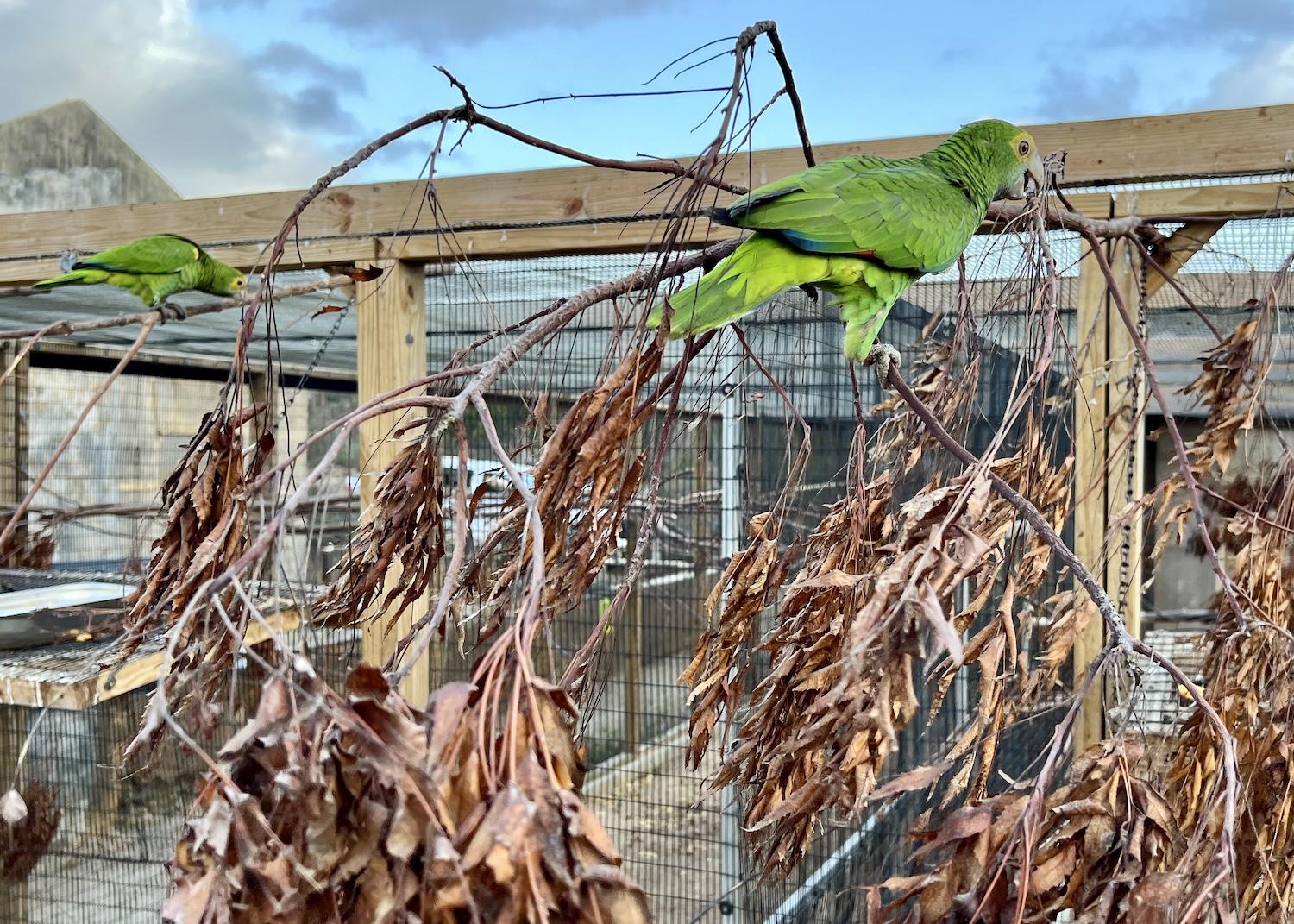
Lora eat neem, an invasive species with medicinal properties, outside their aviary in Arikok National Park. Neem is a member of the mahogany family/Jennifer Bain
“There’s nothing better than seeing them in the wild,” says Silva with pride as we marvel at the remaining birds. “Sometimes people happen to be in the right spot and the flock flies over.”
That just happened with a regular local runner who started screeching, waving and yelling when the flock passed her on the road.
I get a glimmer of that surreal sight and sound when the Loras flee the aviary, but I’ll never forget the first two wild parrots I see — a mated pair peeking out of volcanic rocks along the park’s main paved road.
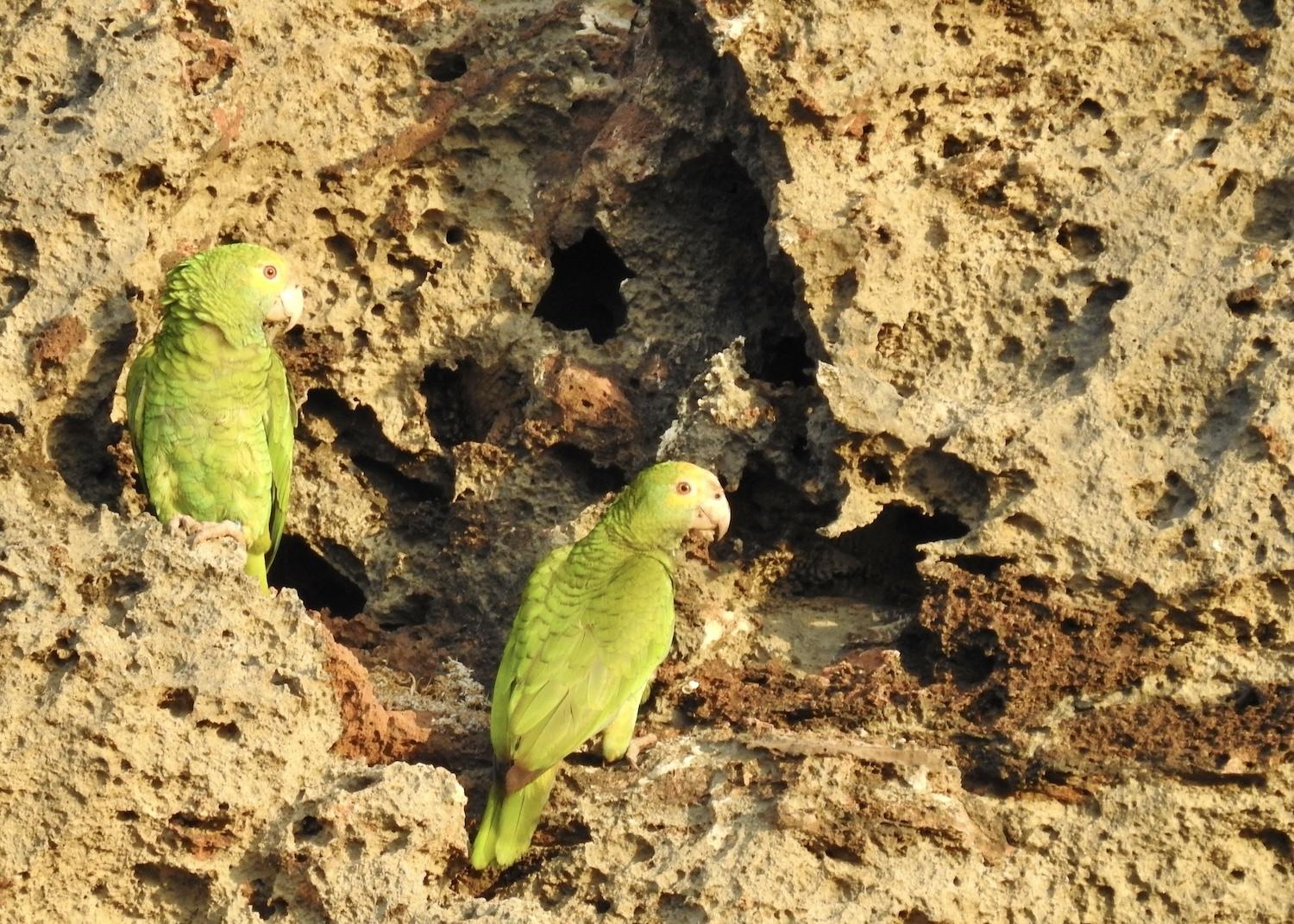
These two Loras seem to be a mated pair scouting nesting areas in the volcanic rocks found along the main road through Arikok National Park/Jennifer Bain
Solagnier tells me he has checked the holes and hasn’t found any eggs.
The parrots could be “playing house,” he theorizes. They could lay eggs that aren’t fertile. Or they could miraculously lay fertile eggs, although they’re officially far too young to breed.
“That would be a first,” says the ranger.
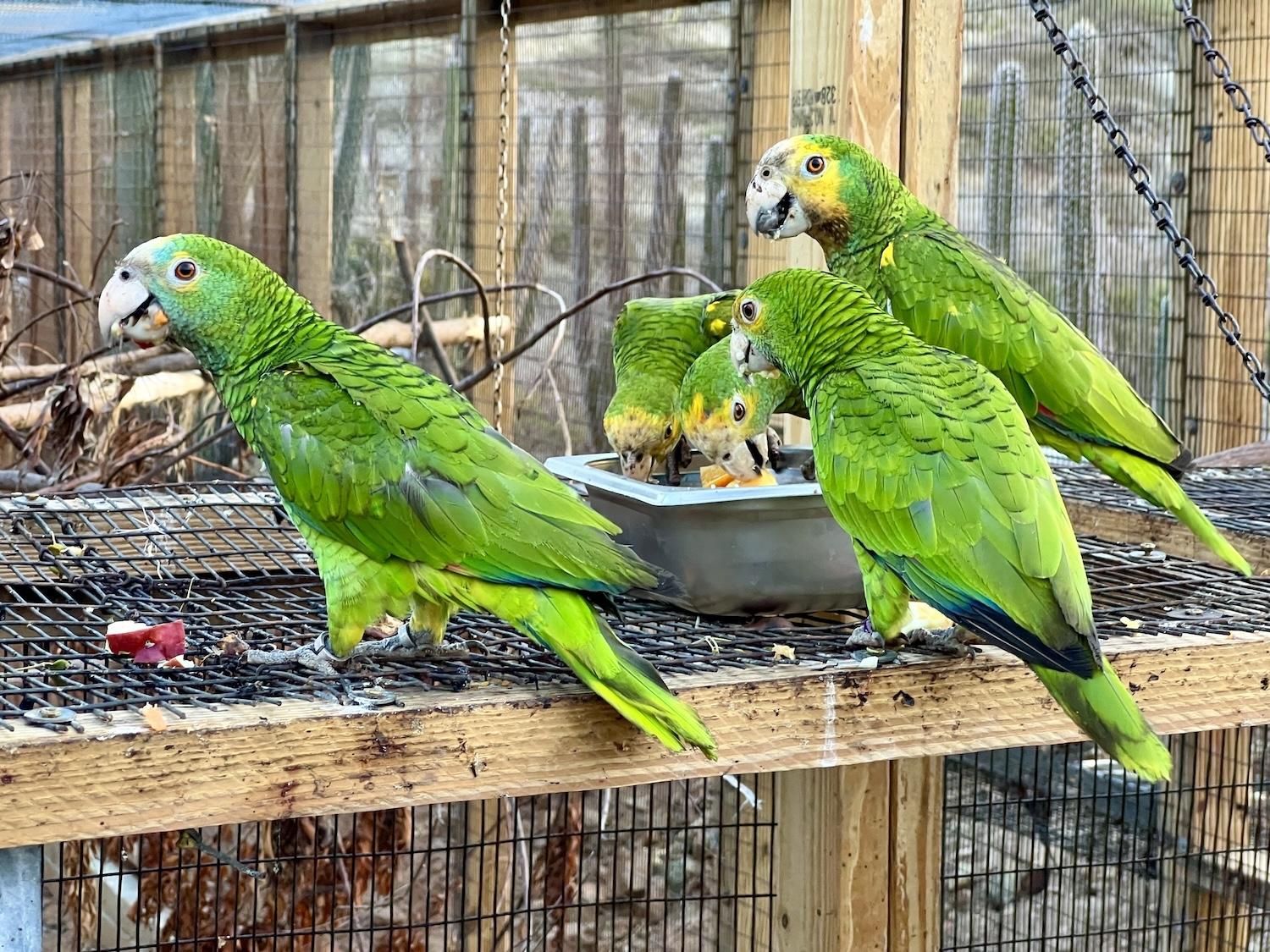
The wild Loras of Arikok National Park were seized in 2022 when the Coast Guard intercepted a boat full of illegal immigrants and poached wildlife/Jennifer Bain
The team shares daily photos and videos with parrot experts around the world. They share one short cellphone video of two birds with me.
“They’re trying to get it on,” says Solagnier.
“They’re completely confused,” Silva agrees. “I think they’re just missing adults to show them what to do. They’re kind of love-hate. They know they should be doing something but they’re also like ‘Hey you’re irritating me and why are you grabbing me?’”
“They remind me of my teenage years,” Solagnier confesses.
It’s all new and exciting work. No two work days are the same. One day, Loras cope with bee stings and learn to eat cactus. Another day the team must pluck a cactus needle from one parrot’s nostril.
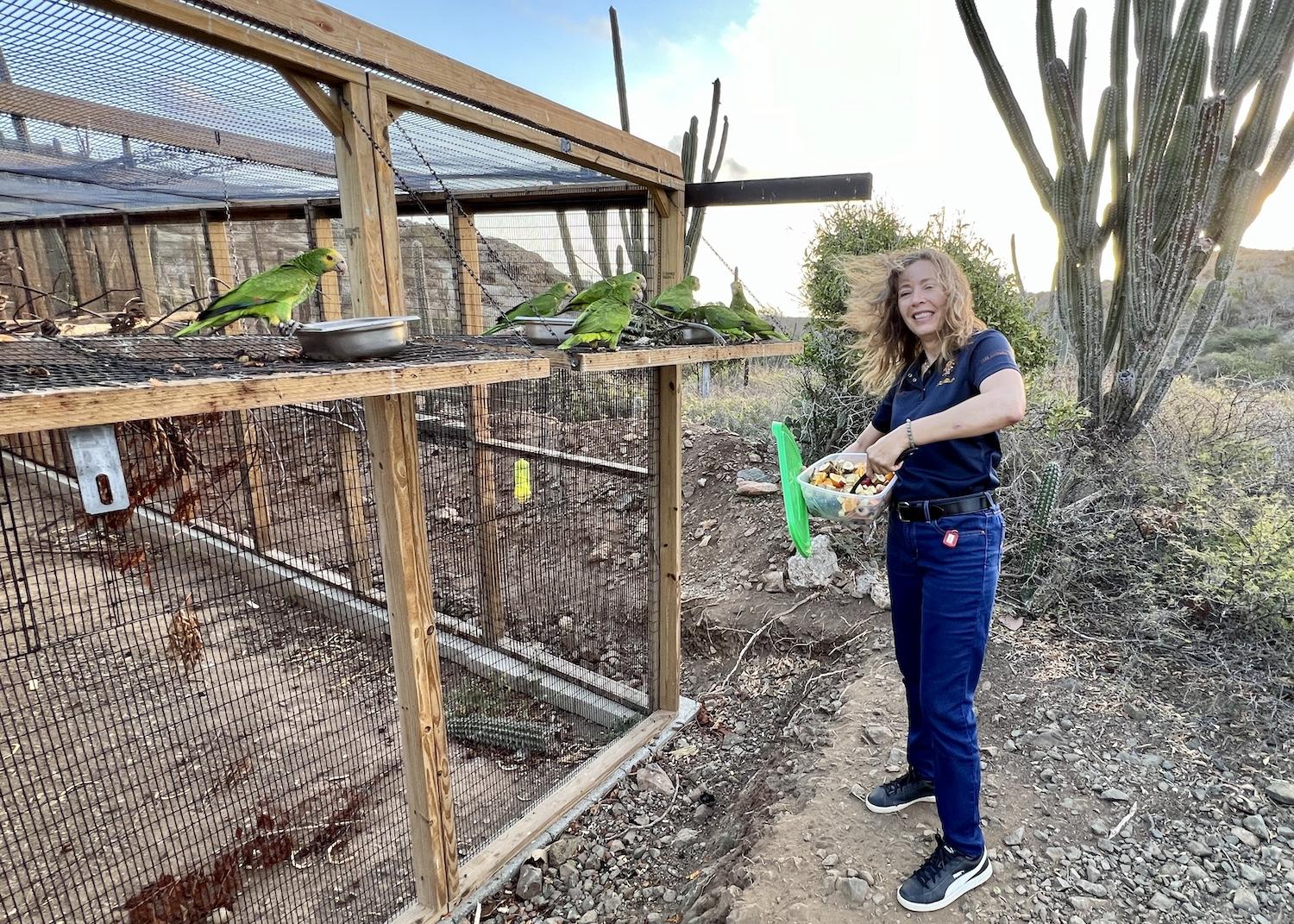
Natasha Silva, chief conservation officer of the Aruba National Park Foundation, offers breakfast to the Loras that were released in Arikok National Park in January/Jennifer Bain
“They’re surprising us every single day and they’re doing quite well,” says Solagnier. “We’re very proud of them. They’re definitely our babies.”
“Are they toddlers now or teenagers?” asks Edeline Berg, the foundation’s communications and marketing manager, who has come for the morning feeding and greenhouse tour.
“They’re kind of going towards teenagers — you can see it in their behaviors,” Silva replies. “They’re becoming less dependent on us. They’re interacting slightly less with us, and more at a distance.”
We hop back in the truck and leave Plantage Prins after just one hour since almost all the Lora left in a hurray. I drive through the park three more times on my own, respectfully avoiding the aviary while hoping to catch a final glimpse of the birds playing house in the volcanic rocks or the flock flying across the road. Alas, it’s not to be — and that’s actually a very good thing.
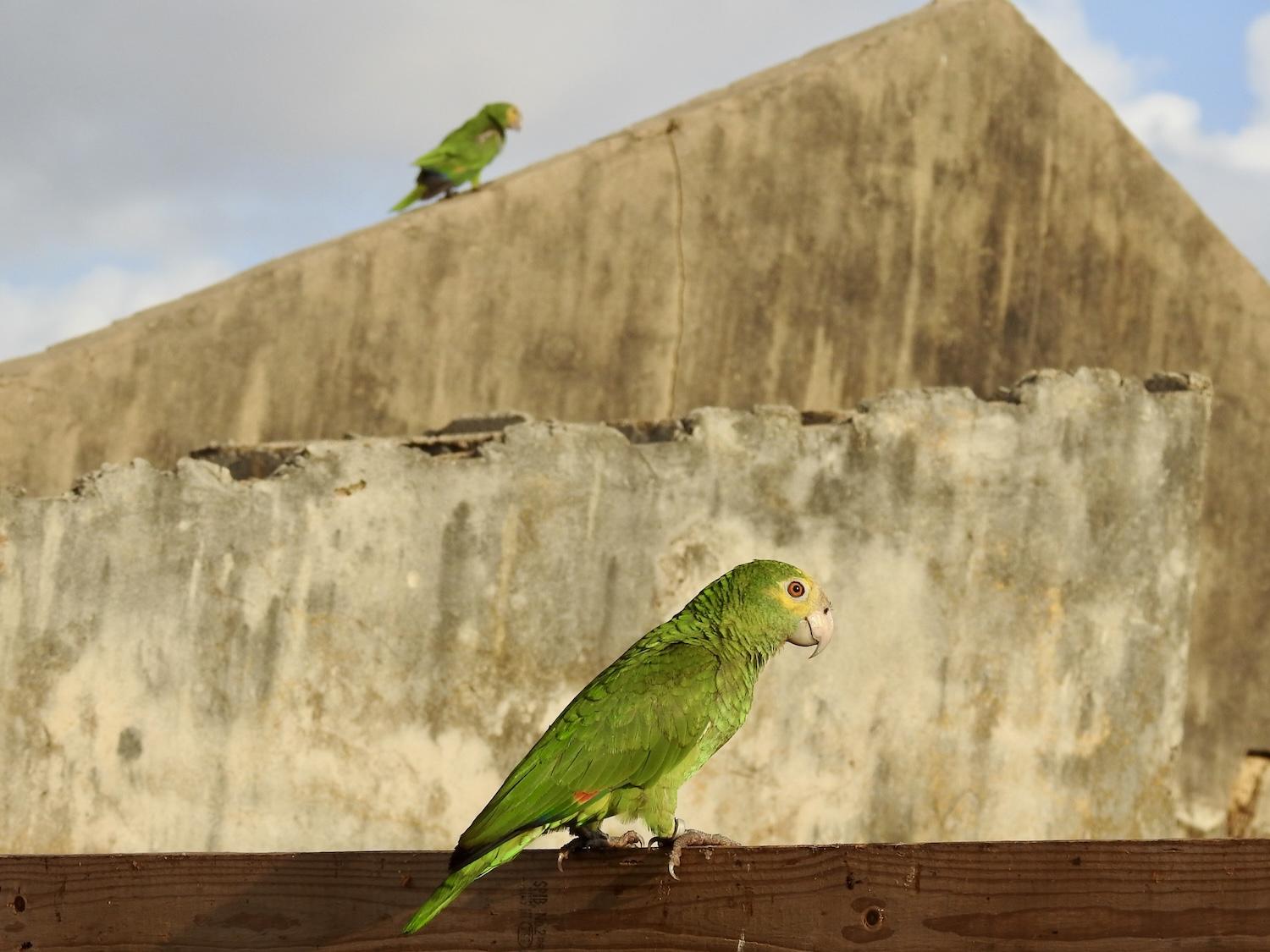
Two Yellow-shouldered amazons, a parrot known as a Lora in Aruba, have made themselves at home at Plantage Prins in Arikok National Park/Jennifer Bain


